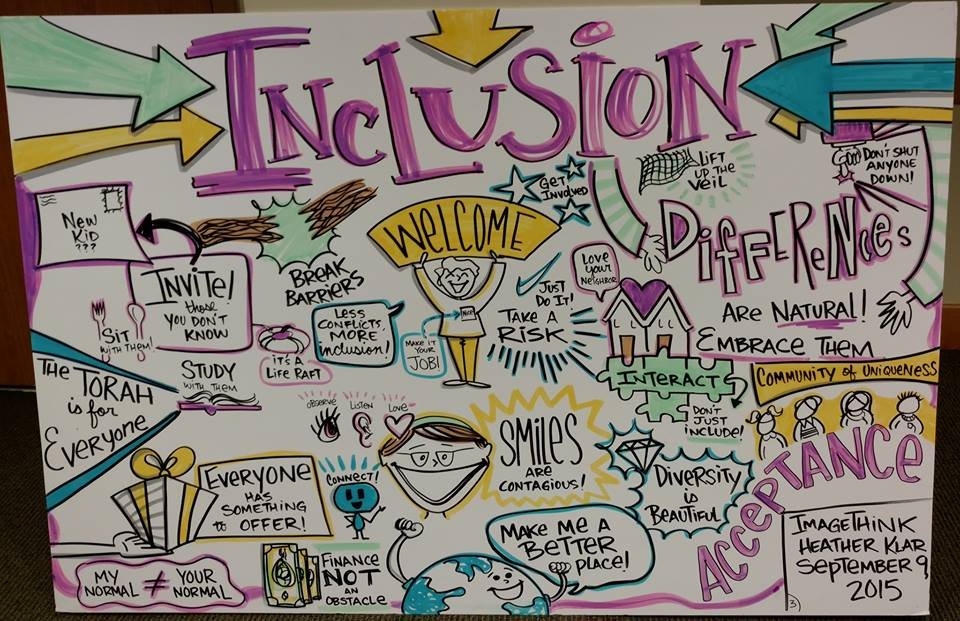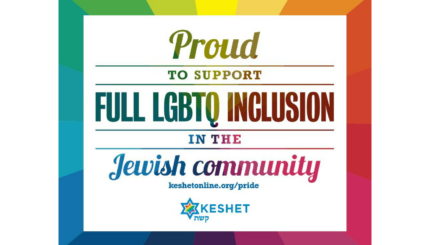Creating inclusive Jewish spaces is a great goal — but how do you do it? While the answer is likely different for every synagogue, school, and youth group, it’s helpful and encouraging to hear about others’ successes, triumphs, and lessons learned. The “Tachlis of Inclusion” series is meant to spotlight practices and policies that have worked for Jewish institutions all over the country. We hope they inspire you.
At UJA Federation’s December conference, Michelle Steinhart, Director of Inclusion at Temple Israel Center, gave a testimonial about the work that her congregation had accomplished as a result of their participation in Keshet’s 2015 Leadership Project with the United Synagogue of Conservative Judaism. We interviewed her to get an in-depth account of her congregation’s impressive accomplishments in the realm of LGBTQ inclusion and the role that our program played in helping them move forward.
In what ways did LGBTQ inclusion — or lack thereof — come up in your congregation prior to participating in the Keshet Leadership Project?
At Temple Israel Center we have an inclusion committee that looks to support anyone who is feeling excluded or alienated for any reason. In the inclusion committee’s exploration, LGBTQ issues definitely came up on our radar. We read about Keshet’s Leadership Project and thought it was the perfect opportunity for us. LGBTQ members weren’t coming to us for help; it was more that our committee was trying to understand where we were or weren’t being effective in this area of inclusion. We knew of a smattering of people who had children who were gay, but we didn’t, and still don’t know of any trans members, although we do have a student who is non-binary. It might have to do with our geographical location in White Plains, NY, or it could be that the trans members are not comfortable sharing yet.
Did you feel that your congregation was inclusive?
Inclusion is a job that’s never done- we can always be more inclusive in the future than we are today. It’s a journey we’re constantly exploring, reflecting, and improving upon, from where we were last year or last month.
What was your experience of the Leadership Summit itself?
We loved it. When we first arrived, we thought we knew everything about inclusion, but we quickly realized how much we didn’t know. It was good to learn from people who wouldn’t judge us for not knowing. The summit was life-changing for us. We walked out in awe of what we didn’t know and what we were able to learn in such a short amount of time.
What sort of coaching did you receive?
We call Phoenix, our coach, for every little thing: what our gender-neutral bathroom signs should look like, what to do when a child started using gender-neutral pronouns and other kids were making mistakes, everything. Phoenix has been embraced by the community and has made sure we schedule a meeting every month. I’ve been through other leadership programs where you have to stay on top of your coach, but with Phoenix, we’re on exactly the same page.
How did your participation in this Keshet program enable your congregation to become more inclusive?
The program enabled us to educate every member of the staff on LGBTQ issues, including the first people who greet you when you walk in and the head rabbi. We have trained the clergy, education and office staff, board, inclusion committee, education council, and ritual committee. All of this enables us to set the stage for real change in the future; the people who will sign off on these changes are now thoroughly educated. For example, the ritual committee is now trained so that we can make changes to rituals, such as calling people up to the Torah. Hebrew is not gender neutral—we don’t know what that means for us in the future, but we now have the tools to figure it out.
What other specific steps have you made towards LGBTQ inclusion?
We’ve made changes to the membership forms for synagogue and schools so that they are no longer heteronormative, and we are working on the language on our website. In our school, we are trying not to use “boys and girls” and instead allow the students to choose their gender of choice (or none at all). We did a training session with one of our 4th graders who is non-binary. We had a panel last year that had a transgender man on it, and our rabbi spoke about LGBTQ issues. On our Night of Empathy, we will be collaborating with Mosaic of Westchester and have an LGBTQ panel discussion. We are also currently working on implementing a non-discrimination policy.
Have you seen or heard of any people –LGBTQ or not — who have benefited from these actions?
We didn’t know that we had a child in our school who was questioning their gender identity until we did a training for that child’s class on gender identity. Their mother never told us that this child was questioning their identity. Now, the parents of LGBTQ children feel more comfortable in our community, because the topic is being discussed. We’re only one year out since the first training, but as we continue to do this work, we begin to hear from more and more people. We’re reaching out to LGBTQ adult congregants who have moved away— who grew up in the community, about what is and isn’t welcoming about our shul. We will continue to reach out to community members who are LGBTQ and their family members to learn how we can be more inclusive.
How have these positive changes you made impacted your community?
Now, if someone feels that they have any issue regarding any form of inclusion, they know that we are open to helping them. When we were only focusing on disabilities- people felt that if they fell into any other category, they wouldn’t be heard. Sometimes simple changes can really go a long way. We are trying to reach out to our entire community so that all people feel welcome and comfortable letting us know about their needs and so that they are able to truly be themselves.
Do you have any advice for synagogue leaders who are thinking of doing the Keshet Leadership Program?
Make sure that it’s not only one person from your community who’s attending the conference. We had two professionals and two lay leaders attend, and I don’t think that any work like this should be with just one person. The project may stop if that one person leaves. You need to put together a solid group of people—speak to clergy and lay leadership. I would urge everyone to take steps toward inclusion.


